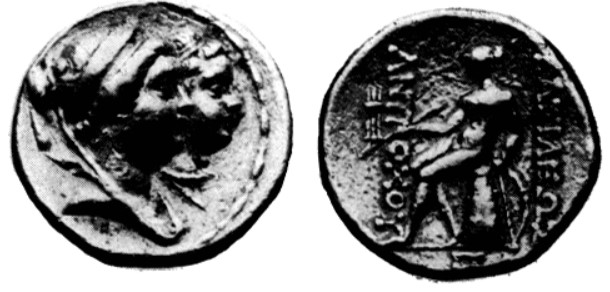Antioch (Antiochus, son of Seleucus IV), gold, octodrachms (Antiochus/Apollo on omphalos) (175 BCE)
From SILVER
(Redirected from H 283b - Antioch (Antiochus IV), gold, octodrachms (175-175 BCE))
175 BCE - 175 BCE Gold 11,081 kg
Description
| ObverseInscription or printing placed on the obverse.: | Jugate busts right of Laodice veiled and wearing diademed stephane, and the child Antiochus, diademed and draped |
| ReverseInscription or printing placed on the reverse.: | BAΣΙΛΕΩΣ ANTIOXΟΥ (Greek).Apollo seated left on omphalos, testing arrow and resting left hand on grounded bow |
Mint and issuing power
| MintIdentifies the place of manufacture or issue of a numismatic object.: | Antioch | Ancient regionAncient region.: | Syria | Modern countryModern country: Turkey | AuthorityIdentifies the issuing power. The authority can be "pretended" when the name or the portrait of X is on the coin but he/she was not the issuing power. It can also be "uncertain" when there is no mention of X on the coin but he/she was the issuing power according to the historical sources: | Antiochus, son of Seleucus IV (Seleucid king, c. 175-170 BC), Seleucid Dynasty (312-63 BC) |
Chronology
| FromIdentifies the initial date in a range assigned in a numismatic context. | 175 BCE | toIdentifies the final date in a range assigned in a numismatic context.. | 175 BCE | PeriodTime period of the numismatic object.: Hellenistic 323-30 BC |
Physical description
| MetalThe physical material (usually metal) from which an object is made.: | Gold |
Median weightMedian of the weights of numismatic objects (in grams). in grams | 34.20 | DenominationTerm indicating the value of a numismatic object. Examples: tetradrachm, chalkous, denarius.: | octodrachm |
StandardStandard.: | Attic |
Image

Antioch,_Antiochus_son_of_Seleucus_octodrachm.jpg [1]
References
| Die study referencePublication of the study: | Mørkholm 19641Mørkholm 1964, Le Rider 19992Le Rider 1999, p. 187 | ||
| Coin series referenceReference to coin series study: | RQEMH3RQEMH, n° 283b, CSE4CSE, n° 91, SC I5SC I, n° 1368 | ||
| Coin series web referenceCoin series web references: | |||
Obverse dies distribution
| FrequencyFrequency of specimen in distribution. ᵖ | Number of obversesNumber of obverse dies. ᵖ (o) | % (o) | Number of coinsNumber of coins. (n) | % (n) | Die nameName(s) of the die(s). |
| 2 | 1 | 100 | 2 | 100 | 1 |
| Total | 1 of 1 | 100 | 2 of 2 | 100 |
Reverse dies distribution
no distribution is available
Quantification
| Number of obversesNumber of obverse dies. ᵖ (o) | 1 | Number of singletons (o1)The number of singleton coins. ᵖ | 0 |
| Number of reverse diesNumber of reverse dies. (r) | 2 | Number of coinsNumber of coins. (n) | 2 |
| Coins per obverse dieNumber of coins per obverse die. (n/o) | 2 | Coins per reverse dieNumber of coins per reverse die. (n/r) | 1 |
| Reverse per obverse ratioRatio of obverse dies divided by reverse dies. (r/o) | 2 | Percentage of singletons (o1)number of coins (n) divided by the number of singletons (o1) ᵖ | 0 % |
| Original number of dies (O) (Carter 1983 formula)The estimation of the number of coins according to Carter 1983 ᵖ | 1.62 | Coins struck if 20,000 as average productivity per dieCoins made if the average productivity for obverses (according to Carter) is 20,000. ᵖ | 32,400 |
| Original number of dies (O) (Esty 2011 formula)The estimation of the number of coins according to the singleton formula in Esty 2011 ᵖ (O) | 2 | Survival rate if 20,000 as average productivity per dieSurvival rate if average productivity is 20,000. ᵖ | 0.00006 |
| Coverage (o = % of O) (Esty 1984 formula)Esty 1984 - coverage (% of O) ᵖ (o = % of O) | 100% | Die productivity if survival rate 1/2,000Average productivity if survival rate is 1/2,000. ᵖ | 2,469.14 |
| Weight of silver (in kg) if 20,000 coins per die (O = Carter formula)Carter 1983 * Median weight * 20000 (*10 if gold or electrum) ᵖ | 11,081 kg <br /> 11,081 kg | Die productivity if survival rate 1/5,000Average productivity if survival rate is 1/5,000. ᵖ | 6,172.84 |
Remarks
Most likely one single workstation
References
- ^ Morkholm, Otto (1964), "The Accession of Antiochos IV of Syria", American Numismatic Society Museum Notes 11, p. 63-76, pl. 14-16.
- ^ Le Rider, Georges (1999), Antioche de Syrie sous les séleucides : corpus des monnaies d'or et d'argent. I, De Séleucos I à Antiochos V, c. 300-161, Mémoires de l'Académie des inscriptions et belles-lettres, n.s. 19, Paris, 260 p., 27 pl.
- ^ Callataÿ, François de (1997), Recueil quantitatif des émissions monétaires hellénistiques, Numismatique Romaine, Wetteren, X + 341 p.
- ^ Houghton, Arthur (1983), Coins of the Seleucid Empire from the collection of Arthur Houghton, Ancient Coins in North American Collections 4, New York, xiv, 122 p., 2 fold. charts, 77 pls.
- ^ Houghton, Arthur - Lorber, Catharine (2002), Seleucid coins : a comprehensive catalogue. Part 1, Seleucus I through Antiochus III, New York - Lancaster - London, 2 v. (xxxviii, 488 p. + 300 p.), 101 pl.